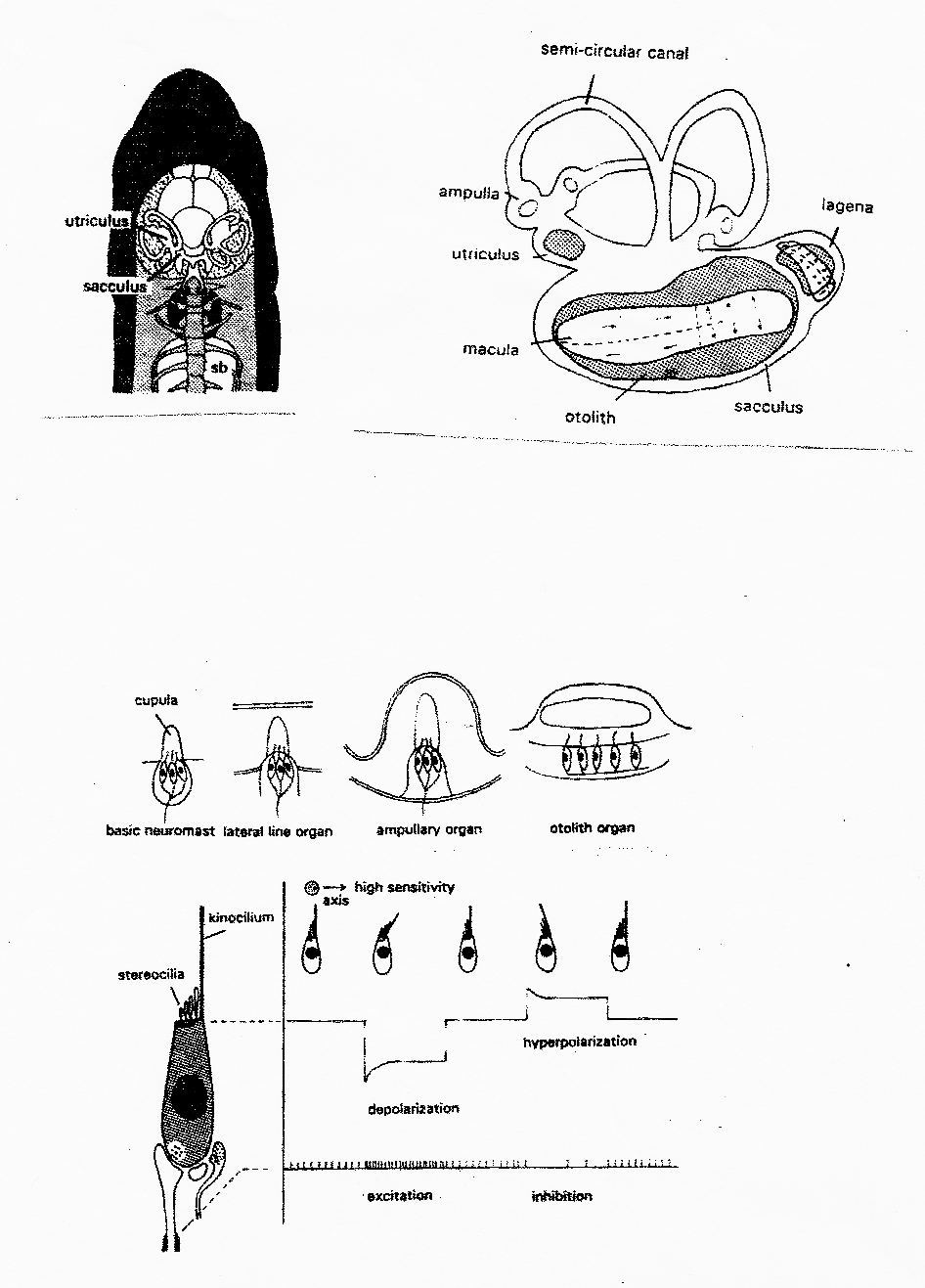
Sensory Systems
The number and relative importance of fishes senses differ from terrestrial organisms. This is a result of differences in the properties of water and air: gas solubility, density, viscosity, propagation of vibrations, electrical conductivity, photon absorption, and refractive index.
Internal Sensory Receptors
Receptors occur for pCO2, pO2, pH, temperature (tunas) etc. Muscle spindles are unknown in fish. Some functionally analogous proprioceptors are known in Myxine, teleost barbels, and fins of rays. The absence of proprioreceptors is probably related to the high density of water.
External Sensory Receptors

Acoustico-Lateralis System
Functions in the detection of vibrations, gravity, and angular acceleration.
Lateral Line
Lateral line neuromasts (cupular organs) respond to near field effects with frequencies up to about 200 Hz (wavelength 7.5 m). Threshold displacement for hair cells is 1-2 nm. Cupular organs probably originated as free external un-polarized (i.e. not sensing direction) near field vibration sensors. Receptors are laid out on a long base so that fish should be able to determine the direction of a sound source by comparing responses of different cupular organs along that baseline.
Hearing
Far field effects are dominant at higher frequencies. Calcium-loaded otoliths lie over the maculae and movements of hair cells against the otoliths stimulate hair cells. Higher frequency far field effects can be detected more effectively if there is a pressure-movement transducer. Some fish transmit volume changes of the gas bladder to the sacculus via bladder extensions or articulating bones series. Weberian ossicles characterize ostariophysians, joining the swim bladder to the sacculus. Many non-ostariophysian fishes have simpler connections, or an air-filled cavity leading to the inner ear. Fish also produce sounds in several ways: grinding teeth, burping, farting, rasping spines and fin rays, gulping air, using the swimbladder as resonator.
Electroreception
Fish from several different groups have electroreceptors of various types, and some also have electric organs. All receptors are derived from lateral line organs, innervated by the lateralis nerve. Some receptors respond to tonic DC signals (elasmobranchs, several teleosts, sturgeon, Polyodon, Dipnoi, probably Latimeria). Others respond to high frequency phasic stimuli (several families of specialized freshwater fish).
Electric organs occur in many fishes. These are derived from muscle, except for freshwater fishes. In many species, electric organs are used in defense or predation.
Visual Systems
The major light-reception organs are the eyes, but also lateral line receptors along body of lamprey, and the pineal in many fish may be light sensitive.
In the eye, refraction takes place almost entirely at the lens, which has a very high refractive index, » 1.69. The lens is almost spherical, but in contrast to a glass sphere, it is almost free of chromatic and spherical aberration. Accommodation occurs by moving the lens, changing focal length.
General Light Environment.
Between darkness and full sunlight there is a continuous range of luminous environments that vary in color and intensity. In darkness, fish produce their own light.
Energies of visible-light photons correspond to colors or wavelengths from violet (400 nm) to deep red (700 nm). As light passes through the water column, the intensity of light decreases due to absorption of photons, and the loss in intensity varies with wavelength. Organic dissolved matter and suspended materials further vary absorption and scattering of light. As a result, background spacelight varies along every line of sight. Consequently fish must detect objects against a background spacelight that has a relatively constant color along any given line of sight, but which varies along different lines of sight.
Fish posses rods and cones. Rods are used in low-light intensity environments. Cones, and color vision, require much more energy than that required to activate rods. Distributions of rods and cones vary with habitats and habits of fishes.
Olfaction
Many fish are extremely sensitive to olfactory stimuli, and large olfactory lobes in the brain are common. Olfaction is used to detect food and in social behavior.